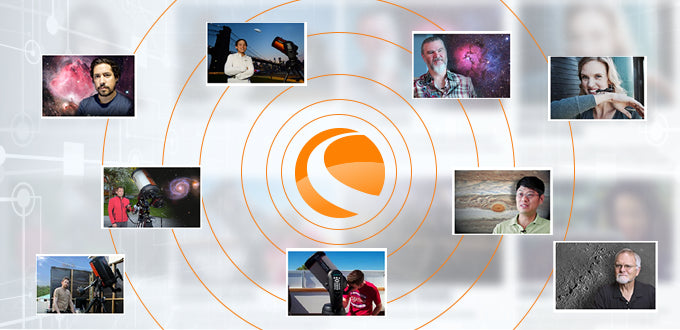The Ultimate Guide to Observing Jupiter
October 9, 2020

Beyond the asteroid belt lies the fifth and most massive planet in the Solar System, Jupiter. Ancient astronomers fittingly named Jupiter after the powerful Roman god. It is the fourth brightest object seen from Earth after the Sun, Moon, and Venus (or fifth, depending on how close Mars is to the Earth).
Jupiter is relatively easy to locate and appears larger and brighter to the naked eye than surrounding stars, so it tends to attract curious stargazers. Millions worldwide credit the sight of mighty Jupiter through a telescope for transforming them from casual observers to serious amateur astronomers.
2020 was an exciting year for observing Jupiter (and Saturn). The two planets drew extremely close in a historic December 21, 2020 encounter. However, they have since parted ways, like two celestial ships passing in the night, leaving behind a wonderful memory that will last a lifetime. With a new opposition season this fall, Jupiter will grace our evening skies again and move into Aries the Ram. So, let's become better acquainted with this gas giant. We will share some important facts about Jupiter, give our recommendations on equipment, point out the planet's must-see features, provide some helpful viewing tips, and more.
Key Jupiter Facts
- Jupiter reaches opposition approximately every 13 months. At its closest point to Earth, Jupiter is about 365 million miles away. At its farthest, it lies about 601 million miles away. In 2023, Jupiter will reach opposition on November 3.
- Scientists believe Jupiter was formed about the same time as the Solar System, so the Jovian planet is approximately 4.6 billion years old.
- Unlike the inner terrestrial planets Mercury, Venus, Earth, and Mars, Jupiter is classified as a gas giant, along with Saturn, Uranus, and Neptune. These planets are composed of gases and may not have a well-defined solid surface. They are much larger than terrestrial planets, are less dense, and have multiple moons.
- Jupiter's atmosphere is comprised of volatile, swirling gases and liquids. Its composition is 90% hydrogen and 10% helium—similar to the Sun. However, Jupiter is not massive enough to ignite a fusion reaction at its core to become a star.
- Jupiter is the fastest-rotating planet in the Solar System. One day on Jupiter is only 10 Earth hours long! Jupiter orbits around the Sun approximately every 12 years at an average speed of 29,236 miles per hour.
- Jupiter boasts the strongest planetary magnetic field in the entire Solar System. Its magnetic field is a million times the volume of Earth's magnetosphere. Trapped charged particles form radiation belts like Earth's Van Allen belts but are much more dangerous and intense.
- Jupiter is 318 times more massive than the Earth. It is so big that all the planets in the Solar System could fit inside Jupiter if it were hollow. 1,300 Earths could easily fit inside Jupiter by themselves.
- About 11 Earths placed side-by-side would match the diameter of Jupiter.
- Scientists estimate between 80 and 95 moons orbiting the planet and counting!
- The Italian astronomer Galileo Galilei discovered the four largest — Io, Europa, Ganymede, and Callisto in 1610 and are known as the Galilean Satellites. Each has its unique characteristics: Io is covered in hundreds of active volcanoes, Europa may have a water ocean that exists beneath its surface that could harbor life, Ganymede is the largest moon in the Solar System, and Callisto might also have an ocean buried deep beneath its icy surface.
- Discovered in 1979 by NASA's Voyager 1 spacecraft, Jupiter has rings, but unlike Saturn's ring system, it is much smaller. Its rings are very faint and cannot be seen in amateur telescopes. They consist of tiny particles due to collisions between Jupiter's moons and meteorites.
- Storms and winds on Jupiter are extremely wicked. These weather fronts can exhibit wind speeds about twice as fast as the strongest hurricanes on Earth. Wind speeds above 360 miles per hour are not uncommon.
- Nine spacecraft have visited Jupiter since the early 1970s, with Pioneer 10 being the first and Juno being the latest (2016). Seven have flown by, while two have orbited the planet.
Use an astronomy app to find Jupiter
Astronomy apps such as Celestron's SkyPortal Powered by SkySafari™ mobile app (included with the purchase of any Celestron telescope) are the easiest and most modern way to help locate and learn about celestial objects. Apps like SkyPortal provide a wealth of information at your fingertips, including audio and written descriptions about Jupiter. But they also offer celestial coordinates, a real-time sky map, rise and set times, and physical and orbital parameters.
The Best Equipment for Viewing Jupiter
|
Telescopes
|
Any small telescope with an aperture of 60mm to 90mm can reveal Jupiter's four brightest moons and the planet's cloud belts and zones. An 8x42 binocular or 9x50 finderscope will easily reveal the four Galilean moons. However, Maksutov-Cassegrain and Schmidt-Cassegrain telescopes (four inches to fourteen inches in aperture) are our best picks for observing Jupiter due to their increased light-gathering ability, longer focal lengths, and ability to accommodate higher magnifications (150x or more). You will not be disappointed with the views as these telescopes can reveal a wealth of detail on Jupiter when seeing conditions allow. Consider using a larger telescope to observe prominent features on Jupiter, such as its belts, festoons, and even its famous Great Red Spot. The larger the telescope's mirror or lens, the more light it will collect for better resolution. However, it will also add more to the cost and weight of the telescope, so carefully consider these factors when choosing your ideal telescope. |
|
Filters |
Color filters are a great way to enhance subtle features in Jupiter's atmosphere for a more enjoyable observing experience. Filters can individually thread onto the end of eyepiece barrels or be stacked together to enjoy the benefits of multiple filters at once. (Please note that when you stack filters, light is diminished. Doing so is only advisable with telescopes with at least 8" of aperture.) Here are the most popular color filters for enhancing details on Jupiter:
Color filters are available in the following Celestron products:
A Variable Polarizing Filter - 1.25" #94107 can be adjusted to reduce light transmission and is beneficial for reducing glare. |
|
Cameras and Phone Adapters
|
Now that you've observed Jupiter visually, take your experience to the next level by capturing detailed images of the king of the planets with your smartphone, DSLR, or a planetary imaging camera. Smartphones' built-in cameras are getting better and better. You can hold your phone up directly to the telescope's eyepiece to take advantage of its image scale with higher magnification to capture the planet and its four brightest moons. You can use the smartphone's digital zoom feature to increase Jupiter's size. It can be tricky to center your target correctly, but using a smartphone adapter like the Basic Phone Adapter #81035 or the NexYZ 3-Axis Universal Smartphone Adapter #81055, centering Jupiter will be quick and easy. DSLR cameras are another popular tool you can use to capture Jupiter. You will need a T-Adapter (different models are available for your telescope) and a camera-specific T-Ring (i.e., Canon, Nikon, etc.). The T-Ring attaches to your camera's bayonet, and the T-Adapter threads onto the T-Ring. Depending on the T-Adapter you are using, it will either slide into the eyepiece drawtube or screw directly onto the telescope's rear cell. Planetary imaging cameras are also a great way to capture high-resolution images with tremendous detail—and getting started is easier than you might think! The camera takes the place of your telescope's eyepiece and connects via USB to your computer or laptop. The software analyzes each frame of the live video capture and throws away blurry images due to poor atmospheric turbulence. It then stacks and perfectly aligns the clearest video frames to create a bright, detailed, colorful image. Celestron's planetary imaging cameras include: |
What to Look for while Observing Jupiter
There are so many cool features to see on and around Jupiter that you can quickly become mesmerized. It is almost as if you are staring at a beautiful, colorful marble – especially while observing through a larger aperture telescope at medium to high magnification. While a camera will certainly pick up more subtle detail than your eyes, you will never be disappointed while visually observing Jupiter on a night of steady seeing.
|
Galilean Moons: Although Jupiter currently has between 80 and 95 moons, you will see 4 of the brightest Galilean moons – Io, Europa, Ganymede, and Callisto. These moons will appear as tiny pinpoints of light at low power through most amateur telescopes and binoculars. But with higher magnification, they will begin to appear as small disks. You'll see how fast these moons travel as they orbit Jupiter; note their positions and check again in an hour or so. Sometimes, you will see these moons passing in front or behind the planet and disappear for a while before reappearing on the other side. At times, a moon may cast its shadow on Jupiter's clouds and appear as a tiny "black dot," slowly moving across the planet as the hours pass. This dot is called a shadow transit, which occurs quite frequently. Sometimes, you might be lucky to observe a double or even rarer triple transit.
|
|
Belts and Zones: When we observe Jupiter, we look at its clouds' top layer. Cloud bands have different temperatures and chemical makeup that results in different colors. Dark-colored bands are known as "belts," while light-colored bands are "zones." Reddish clouds are found at higher altitudes, while brown/cream-colored clouds are found at mid-level regions, and bluish clouds are found at the lowest altitudes. The view will reveal the two main cloud belts that appear as dark stripes across Jupiter's surface in a modest telescope. Depending on the size of your telescope and current atmospheric conditions, it may be possible to see shadings towards the poles. With increased magnification, you may glimpse white and dark ovals, bluish swirls within the bands called festoons, and other odd markings. It is always interesting to explore Jupiter's constantly changing face as new areas of the planet rotate into view.  |
|
Great Red Spot: Jupiter's famous Great Red Spot, or GRS for short, was discovered in 1665 by Italian astronomer Giovanni Cassini. Located in Jupiter's Southern Hemisphere, the GRS is an anticyclonic storm measuring nearly 15,000 miles in diameter and is large enough to contain at least two Earths side by side. It has been around for at least 350 years but has noticeably shrunken in size. Its winds can reach over 270 miles per hour – faster than Earth's strongest hurricane wind speed ever recorded. The GRS will sometimes be behind the planet, so you must be patient and wait for it to rotate back into view. Celestron's SkyPortal app is a great tool to help you precisely time when the GRS will be visible from your viewing location.
|
|
Impact Markings: Occasionally, Jupiter's powerful gravity will tug at asteroids, comets, and other space debris and force them to smack into the planet, leaving dark bruises in its clouds. The most famous of these impact strikes occurred back in 1994. Comet Shoemaker-Levy 9 had broken apart over two years before it approached Jupiter. Like a 20-plus car train, the comet's remains crashed into Jupiter's clouds. The dark scars it left behind were easily visible through amateur telescopes.
|
|
Conjunctions: Planetary alignments, or conjunctions, occur when two or more planets appear very close together in the night sky. They are often spectacular to see—especially if they involve the largest or brightest planets. Such a great conjunction occurred on the evening of the winter solstice, December 21, 2020, when Jupiter and Saturn were separated by only 0.1 degrees – meaning both planets were visible in the same telescopic field of view! Many observers from around the world witnessed this historic super conjunction!
|
Jupiter's long-awaited opposition takes place in November!
Evening: Visible from November 2-3 to December 31 (end of the calendar year)
- Jupiter will be closest to Earth on November 1-2, 2023, but reaches opposition on November 2-3, 2023, when it lies opposite the Sun in our sky and is 370 million miles away.
- Jupiter will shine brightly at magnitude -2.9 and will be 49.5 arcseconds across! Jupiter will be visible all night long and 100% illuminated.
- Jupiter reaches opposition every 13 months and resides in a new constellation yearly. In 2023, it will be located in Aries.
- Look for the Pleiades star cluster and the planet Uranus near Jupiter.
|
Tip #1:
|
Steady seeing conditions are critical when imaging or observing Jupiter. Avoid nights of bad seeing when our atmosphere is turbulent, and Jupiter appears like a shimmering blob on your laptop screen or in a telescope eyepiece. Start with low magnification and work up if the views remain steady. During a night of good seeing, details on Jupiter will "pop" into view, and the Great Red Spot will be bright and noticeable. |
|
Tip #2:
|
Make sure you bring your telescope outside about an hour or so before you plan to observe to cool it to ambient temperature. To avoid distorted views, the telescope must reach thermal equilibrium with the outside air temperature. Telescopes with large mirrors and lenses may take longer to cool down for the best views. |
|
Tip #3:
|
If you own a Newtonian or Schmidt-Cassegrain telescope, ensure your telescope's optics are collimated. It can make a difference when it comes to discerning fine planetary detail. If the optics are slightly out of alignment, you may be cheating yourself out of seeing the clearest and sharpest details on Jupiter. Make it a habit to check collimation and adjust once your telescope is cooled down. Most refractor telescopes generally do not need to be collimated. |
Jupiter might be the most exciting planet to observe through a telescope. It is big, bright, and rotates rapidly. Jupiter's storms are always in constant motion while its four bright moons race around the planet. And, of course, it has the most distinct marking of the planets in the solar system – the Great Red Spot. Jupiter is an imaging and visual observer's dream as its appearance constantly changes night after night. We hope this guide helped you get acquainted with Jupiter and will be an excellent resource for you and your family during your next observing session.
Clear skies and happy observing!
Other articles you might be interested in: Ultimate Guide to Observing the Universe





































